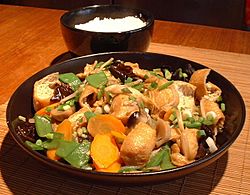Buddha's delight facts for kids
 |
|
| Alternative names | Luóhàn zhāi, lo han jai, lo hon jai, Luóhàn cài |
|---|---|
| Course | Main dishes |
| Place of origin | China |
| Main ingredients | various edible plants, fungi and soy sauce |
| Buddha's delight | |||||||||||||||
|---|---|---|---|---|---|---|---|---|---|---|---|---|---|---|---|
| Traditional Chinese | 羅漢齋 or 齋 | ||||||||||||||
| Simplified Chinese | 罗汉斋 or 斋 | ||||||||||||||
| Literal meaning | Luohan vegetarian food | ||||||||||||||
|
|||||||||||||||
Buddha's delight is a famous vegetarian dish from China. It is also known by names like Luóhàn zhāi, lo han jai, or lo hon jai. Sometimes, people call it Luóhàn cài (simplified Chinese: 罗汉菜; traditional Chinese: 羅漢菜).
This special meal is traditionally eaten by Buddhist monks because they follow a vegetarian diet. However, it has become very popular all over the world. You can often find it as a vegetarian choice in Chinese restaurants.
Buddha's delight is made with many different vegetables and other plant-based ingredients. These are cooked in a tasty liquid, usually with soy sauce and other spices, until they are soft. The exact ingredients can be different depending on where it's made.
Contents
What's in the Name?
The name luóhàn zhāi has a special meaning. Luóhàn comes from the word arhat in an old language called Sanskrit. An arhat is a wise and peaceful person in Buddhism, like the Buddha himself.
The word zhāi (simplified Chinese: 斋; traditional Chinese: 齋; pinyin: zhāi) means "vegetarian food" or "vegetarian diet." So, the name means "vegetarian food of the enlightened ones."
This dish usually has at least 10 different ingredients. Some fancy versions can even have 18 or 35 ingredients! If it has 18 ingredients, it's called luóhàn quánzhāi.
In places like China and Hong Kong, if the dish uses only the most flavorful vegetarian ingredients, it's called tián suān zhāi. This means "sweet and sour vegetarian dish."
Traditions and Celebrations
As its name suggests, Buddha's delight is a dish deeply connected to Buddhist traditions. It's not just for monks anymore; many people enjoy it.
It is a tradition for Chinese families to eat this dish on the first day of the Chinese New Year. This comes from an old Buddhist custom. People would eat only vegetarian food for the first five days of the new year. It was a way to cleanse themselves and start the year fresh.
Some rare ingredients, like fat choy (a black hair-like plant) and arrowhead, are often eaten only during this time of year.
Traditionally, this dish does not include eggs or dairy products. Also, certain strong-smelling vegetables like Alliums (onions, garlic) are not used. This is because they are not allowed in traditional Buddhist cuisine.
Main Ingredients You Might Find
Buddha's delight can have many different ingredients. Each one often has a special lucky meaning in Chinese culture. Not every version of the dish will use all of these, as recipes can vary.
Common Ingredients
- Arrowhead (慈菇 or 茨菰)
- Bamboo fungus (竹笙 or 竹荪)
- Bamboo shoots (笋)
- Bean curd sticks (腐竹)
- Black mushrooms (冬菇)
- Carrot (胡萝卜)
- Cellophane noodles (粉絲), also called "bean threads"
- Daylily buds (金针), also called "golden needles"
- Fat choy (髮菜), a black hair-like plant
- Ginkgo nuts (銀杏 or 白果)
- Lotus seeds (蓮子)
- Napa cabbage (大白菜)
- Peanuts (花生)
- Snow peas (荷蘭豆)
- Fried tofu (炸豆腐)
- Water chestnuts (荸薺)
- Fried or braised wheat gluten (麵筋)
- Wood ear (木耳), also called black fungus
Seasonings for Flavor
- Ginger (姜)
- Vegetable oil (like peanut or sesame oil)
- Vegetarian Oyster sauce (斋蚝油)
- Pickled tofu (豆腐乳), both red and white kinds
- Salt (鹽)
- Dark soy sauce (老抽)
- Starch (淀粉)
- Sugar (糖)
Images for kids
-
This picture shows dishes from a Buddhist temple's vegetarian restaurant in Qibao. Buddha's delight is at the bottom, called "Braised Shiitake and Wheat Gluten in a pot."
See also
 In Spanish: Delicias de Buda para niños
In Spanish: Delicias de Buda para niños


